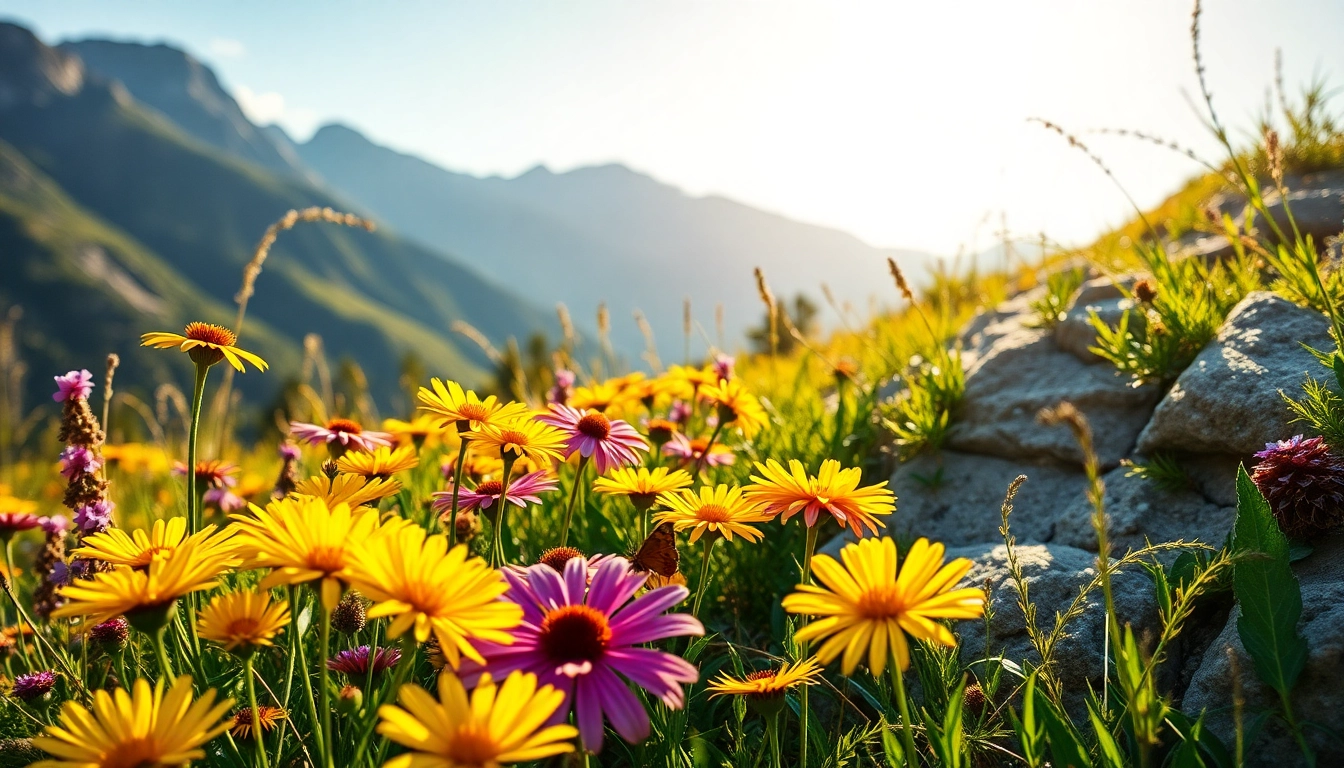Understanding Wildflowers: A Foundation
Wildflowers represent a captivating element of nature, showcasing beauty and vibrancy that enriches landscapes. These flowers serve a critical role in ecosystems, contributing to biodiversity and the overall health of our planet. At www.sudswild.com, we explore the many facets of wildflowers, emphasizing their importance, diversity, and ecological benefits.
What Are Wildflowers and Their Importance?
Wildflowers are flowering plants that grow in natural conditions without deliberate human cultivation. They are often characterized by their vibrant colors, unique shapes, and varying blooming seasons. The importance of wildflowers extends beyond their aesthetic appeal; they play vital roles in ecosystems by supporting pollinators, improving soil health, and serving as ornamental elements in gardens and landscapes.
From bees to butterflies, wildflowers provide essential nectar and pollen, enhancing biodiversity. Furthermore, they have the capability to thrive in various environmental conditions, adapting to local climates and soil types, which makes them crucial for maintaining ecological balance.
Different Types of Wildflowers Across Regions
Wildflowers vary significantly based on regional climates, soil types, and ecosystems. Let’s explore some notable examples:
- Prairie Wildflowers: Found in North America, plants such as the Black-eyed Susan (Rudbeckia hirta) and the Purple Coneflower (Echinacea purpurea) thrive in open, sunny areas.
- Mountain Wildflowers: In high-altitude regions, you can find species like the Mountain Avens (Dryas octopetala) and Alpine Forget-me-not (Myosotis alpestris), which are adapted to cooler temperatures.
- Desert Wildflowers: Desert regions boast unique varieties, including the California Poppy (Eschscholzia californica) and Desert Bluebell (Phacelia campanularia), which bloom after rare rainfalls.
Benefits of Wildflower Planting
Planting wildflowers brings numerous benefits, not just for aesthetics but also for ecological health:
- Promoting Pollinator Habitats: Wildflowers serve as a critical food source for bees, butterflies, birds, and other wildlife, enhancing biodiversity.
- Soil Erosion Control: Their deep-root systems help stabilize soil, reducing erosion and promoting healthier ecosystems.
- Water Conservation: Many wildflowers are drought-resistant, helping gardens thrive with less watering.
Choosing the Right Varieties for Your Garden
When selecting wildflowers for your garden, it’s essential to consider various factors to ensure a successful planting experience. Whether you’re aiming to attract pollinators or create stunning visual displays, making informed choices is key.
Native vs. Non-Native Wildflowers
Choosing between native and non-native wildflowers can influence not only the appearance of your garden but its ecological impact as well. Native wildflowers are adapted to local conditions and play a vital role in local ecosystems.
Non-native species might offer beauty and novelty, but they can disrupt local ecosystems if not managed properly. For instance, while the Non-Native Ornamental Bluebell (Hyacinthoides non-scripta) may add charm to gardens, it might compete with native species for resources.
Factors to Consider When Selecting Wildflowers
Several key factors should influence your wildflower selection process:
- Climate: Choose species that thrive in your local climate zone.
- Soil Type: Conduct a soil test to determine pH and nutrient levels; some wildflowers prefer sandy soil, while others flourish in clay.
- Sun Exposure: Assess the amount of sunlight your garden area receives—certain species flourish in full sun while others prefer partial shade.
Popular Wildflower Varieties for Color and Biodiversity
For a vibrant and diverse wildflower garden, consider incorporating these popular varieties:
- Black-eyed Susan: Known for their bright yellow blooms, these flowers attract pollinators and thrive in various conditions.
- Butterfly Weed: A favorite among butterflies, this native plant produces clusters of orange flowers and prefers dry soil.
- Indian Paintbrush: With unique red feathery blooms, this flower adds an artistic touch to any garden.
Creating a Wildflower Garden: Step-by-Step Guide
Establishing a wildflower garden requires thoughtful planning and execution. By following a systematic approach, you can create a thriving environment for these stunning blooms.
Preparing Your Land for Planting
Before planting, proper land preparation is crucial:
- Select the Right Site: Choose an area that receives adequate sunlight and has good soil drainage.
- Clear the Area: Remove any existing vegetation and debris to avoid competition with your new plants.
- Tilling the Soil: Loosen the soil with a tiller or garden fork to facilitate seed germination.
Seeding Techniques for Wildflowers
The way you seed wildflowers can significantly affect their success:
- Seed Mixing: Mix wildflower seeds with a carrier like sand for even distribution.
- Broadcasting: Disperse the seed mixture evenly over the prepared area.
- Raking: Lightly rake the top layer of soil to cover the seeds, ensuring they remain in contact with the soil.
Maintenance Tips for Thriving Wildflower Gardens
Maintaining a wildflower garden doesn’t have to be a daunting task. Here are some helpful maintenance tips:
- Watering: Establish an initial watering routine until plants are well-established; afterward, many wildflowers need little to no irrigation.
- Weeding: Regularly remove weeds to eliminate competition for nutrients and water.
- Monitoring Pests: Keep an eye on pest infestations, making sure to use eco-friendly control methods.
Wildflower Gardens and Ecosystem Benefits
The impact of wildflower gardens extends beyond personal enjoyment; they contribute positively to local ecosystems.
Supporting Local Pollinators Through Wildflower Gardens
Wildflowers provide essential resources for various pollinators, which are crucial for the reproduction of many plants. By planting native wildflowers, you are creating a welcoming environment for bees, butterflies, and other pollinators. This support not only helps sustain these species but also increases the productivity of your garden.
Improving Soil Health with Wildflowers
The presence of wildflowers in a garden can enhance soil health. Deep root systems aerate the soil and improve drainage, while organic matter from fallen leaves and decomposing flowers enrich the ground. Moreover, certain wildflowers can fix nitrogen levels in the soil, improving fertility.
The Role of Wildflowers in Climate Resilience
As climate change poses significant threats to global ecosystems, wildflowers play a role in enhancing resilience. They can adapt to varying weather conditions, thus maintaining environmental integrity. Their ability to thrive in challenging conditions makes them essential for developing landscapes that can withstand climate-related stresses.
Showcasing Your Wildflower Garden
A wildflower garden is a living art piece—one that deserves to be showcased and shared. Here are ways to document and present your garden journey:
Documenting Growth and Seasonal Changes
Keeping a journal or a digital record of your wildflower garden can be rewarding. Taking photos at different growth stages allows you to appreciate progress over time. Journaling can also help track what works best for your wildflower varieties.
Sharing Your Wildflower Journey on Social Media
Social media platforms offer opportunities to showcase your wildflower gardening experience to a broader audience. Sharing your successes and challenges can inspire others to start their own wildflower gardens. Join gardening groups or hashtags such as #WildflowerGarden or #PollinatorFriendly to connect with like-minded individuals.
Inspiring Others: Community Wildflower Projects
Taking your passion for wildflowers beyond your garden can greatly benefit your community. Initiatives like community garden projects or local wildflower planting events help increase awareness about the importance of these beautiful plants. Working together can create habitats for wildlife, promote biodiversity, and foster community spirit.



